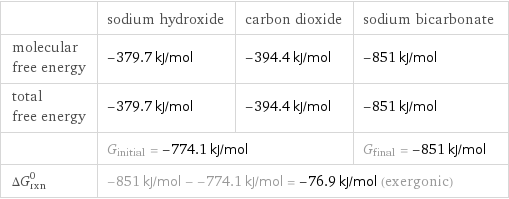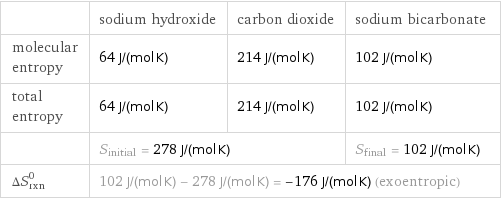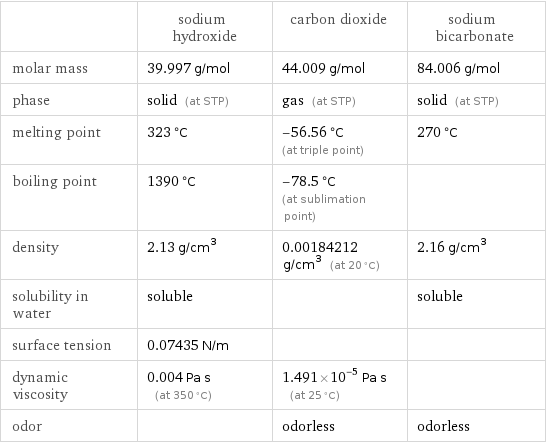Input interpretation

sodium hydroxide + carbon dioxide ⟶ sodium bicarbonate
Balanced equation

Balance the chemical equation algebraically: + ⟶ Add stoichiometric coefficients, c_i, to the reactants and products: c_1 + c_2 ⟶ c_3 Set the number of atoms in the reactants equal to the number of atoms in the products for H, Na, O and C: H: | c_1 = c_3 Na: | c_1 = c_3 O: | c_1 + 2 c_2 = 3 c_3 C: | c_2 = c_3 Since the coefficients are relative quantities and underdetermined, choose a coefficient to set arbitrarily. To keep the coefficients small, the arbitrary value is ordinarily one. For instance, set c_1 = 1 and solve the system of equations for the remaining coefficients: c_1 = 1 c_2 = 1 c_3 = 1 Substitute the coefficients into the chemical reaction to obtain the balanced equation: Answer: | | + ⟶
Structures

+ ⟶
Names

sodium hydroxide + carbon dioxide ⟶ sodium bicarbonate
Reaction thermodynamics
Enthalpy

| sodium hydroxide | carbon dioxide | sodium bicarbonate molecular enthalpy | -425.8 kJ/mol | -393.5 kJ/mol | -950.8 kJ/mol total enthalpy | -425.8 kJ/mol | -393.5 kJ/mol | -950.8 kJ/mol | H_initial = -819.3 kJ/mol | | H_final = -950.8 kJ/mol ΔH_rxn^0 | -950.8 kJ/mol - -819.3 kJ/mol = -131.5 kJ/mol (exothermic) | |
Gibbs free energy

| sodium hydroxide | carbon dioxide | sodium bicarbonate molecular free energy | -379.7 kJ/mol | -394.4 kJ/mol | -851 kJ/mol total free energy | -379.7 kJ/mol | -394.4 kJ/mol | -851 kJ/mol | G_initial = -774.1 kJ/mol | | G_final = -851 kJ/mol ΔG_rxn^0 | -851 kJ/mol - -774.1 kJ/mol = -76.9 kJ/mol (exergonic) | |
Entropy

| sodium hydroxide | carbon dioxide | sodium bicarbonate molecular entropy | 64 J/(mol K) | 214 J/(mol K) | 102 J/(mol K) total entropy | 64 J/(mol K) | 214 J/(mol K) | 102 J/(mol K) | S_initial = 278 J/(mol K) | | S_final = 102 J/(mol K) ΔS_rxn^0 | 102 J/(mol K) - 278 J/(mol K) = -176 J/(mol K) (exoentropic) | |
Chemical names and formulas

| sodium hydroxide | carbon dioxide | sodium bicarbonate Hill formula | HNaO | CO_2 | CHNaO_3 name | sodium hydroxide | carbon dioxide | sodium bicarbonate IUPAC name | sodium hydroxide | carbon dioxide | sodium hydrogen carbonate
Substance properties

| sodium hydroxide | carbon dioxide | sodium bicarbonate molar mass | 39.997 g/mol | 44.009 g/mol | 84.006 g/mol phase | solid (at STP) | gas (at STP) | solid (at STP) melting point | 323 °C | -56.56 °C (at triple point) | 270 °C boiling point | 1390 °C | -78.5 °C (at sublimation point) | density | 2.13 g/cm^3 | 0.00184212 g/cm^3 (at 20 °C) | 2.16 g/cm^3 solubility in water | soluble | | soluble surface tension | 0.07435 N/m | | dynamic viscosity | 0.004 Pa s (at 350 °C) | 1.491×10^-5 Pa s (at 25 °C) | odor | | odorless | odorless
Units
